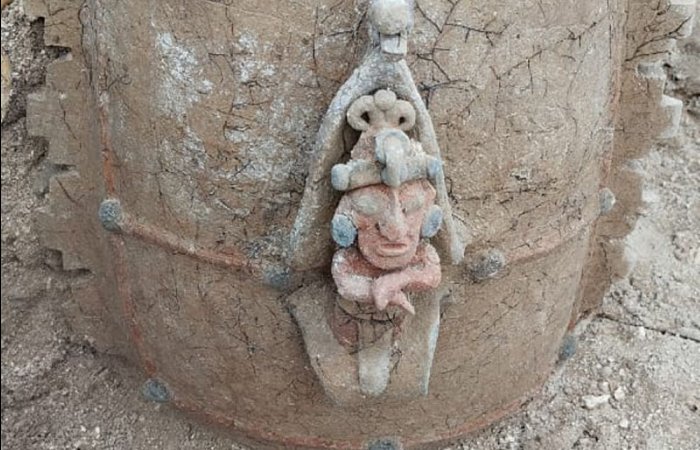Conny Waters - AncientPages.com - While conducting salvage works of Section 7 of the Mayan Train, a team of archaeologists from the National Institute of Anthropology and History (INAH) unearthed a funerary urn representing the god of corn.
Funerary urn depicting the god of corn. Photo: INAH.
The director general of the INAH, Diego Prieto Hernández, informed in the morning press conference that, in terms of its typology, the unearthed urn has been identified by the researchers as a Paaktzatz-style vessel.
Additionally, the archaeologist explained that the element was placed next to another vessel of the same typology, so it is thought that it was part of a foundational offering due to its association with a pre-Hispanic building: "It is a raw clay pot that contains the mortal remains of a person."
The urn retains applications on its body, representing the Mayan symbol “ik,” alluding to the wind and the divine breath. On the obverse is a small anthropomorphic figure made with pastilles, which alludes to the god of corn in his representation as an ear of corn in the growth stage,” writes INAH.
Another interesting feature of the urn is the lid, which represents an owl, a symbol shared with the second vessel of this offering.
In Mayan iconography, the owl was considered a bird of doom and a symbol of war during the Classic period, as recorded in the Paaktzatz vessels made between 680 and 770 A.D., in the cultural area known as the Bec River. Owls are revered by the Maya people and are thought to be a sign of good luck. They are often seen as a protective spirit animal and are believed to be able to see into the future. However, these birds are also associated with death and the afterlife, and guide the soul to the underworld.Many believe they represent signs of death.
The ornamentation of the second vessel consists of applications on the sides, which simulate the thorns of a ceiba tree, a sacred tree among the Mayans of the past and present.
Archaeologists stated that similar images of the Maya deity have been found in figurines from the island of Jaina, in Campeche
The archaeological salvage works conducted in sections 5, 6 and 7 of the Mayan Train, have delivered numerous items including thousands of ceramic fragments, pieces of furniture, thousands of ceramic potsherds, natural features associated with the presence of human groups.
Written by Conny Waters - AncientPages.com Staff Writer
